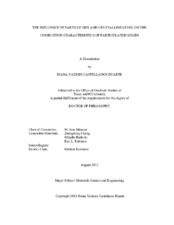| dc.description.abstract | Over the past years, catastrophic dust explosion incidents have caused numerous injuries, fatalities and economical losses. Dust explosions are rapid exothermic reactions that take place when a combustible dust is mixed with air in the presence of an ignition source within a confined space. A variety of strategies are currently available to prevent dust explosion accidents. However, the recurrence of these tragic events confirms flaws in process safety for dust handling industries. This dissertation reports advances in different approaches that can be followed to prevent and mitigate dust explosions. For this research, a 36 L dust explosion vessel was designed, assembled and automated to perform controlled dust explosion experiments.
First, we explored the effect of size polydispersity on the evolution of aluminum dust explosions. By modifying systematically the span of the particle size distribution we demonstrated the dramatic effect of polydispersity on the initiation and propagation of aluminum dust explosions. A semi-empirical combustion model was used to quantify the laminar burning velocity at varying particle size. Moreover, correlations between ignition sensitivity and rate of pressure rise with polydispersity were developed. Second, we analyzed the effect of particle size and crystalline levels in the decomposition reactions of explosion inhibitor agents (i.e., phosphates). We fractionated ammonium phosphate- monobasic (NH_4H_2PO_4) and dibasic ((NH_4)_2HPO_4) at different size ranges, and synthesized zirconium phosphate (Zr(HPO_4)_2·H_2O) at varying size and crystalline levels. Particle size was found to be crucial to improve the rate of heat absorption of each inhibitor. A simplified model was developed to identify factors dominating the efficiency of dust explosion inhibitors. Finally, we conducted computational fluid dynamic (CFD) simulations to predict overpressures in dust explosions vented through ducts in large scale scenarios. We particularly focused on the adverse effects caused by flow restrictions in vent ducts. Critical parameters, including ignition position, geometric configuration of the vent duct, and obstructions of outflow such as bends and panels were investigated. Comparison between simulation and experimental results elucidated potential improvements in available guidelines.
The theoretical analyses complemented the experimental work to provide a better understanding of the effects of particle size on the evolution of dust explosions. Furthermore, the validation of advanced simulation tools is considered crucial to overcome current limitations in predicting dust explosions in large scale scenarios. | en |


